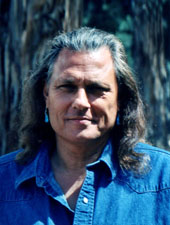
In the midst of the worst time in her life, Michelle Kenidi had a stroke of
good luck. While searching for her missing daughter in Calgary, she met
a kindhearted psychologist from the American Southwest, Andrew One Sky.
Thus in Season 4 did Michael Horse join the cast of "North of 60."
PW: I was reading some biographical materials on you, and it sounds as though you fell into acting accidentally. Was that the case?
MH: Yeah, yeah. I've been an artist, that's basically what I do. I come from a long line of native artists, very famous potters, jewelers. I had dabbled in the movie business a little bit. I was a wrangler; I used to have horses for the movies. And a very bad rodeo rider! I was renting my art studio from an agent when they were doing the remake of "The Lone Ranger" movie--this was in 1980 and I was still quite young. And she came running down there and said, "Do you want to be Tonto in 'The Lone Ranger'?" And I went, "Nooo..." I knew Jay [Silverheels] very well. We just did a documentary on his life.

|
PW: You mean the episode of "The Canadians" about him?
MH: Yeah. Jay was a great man, and a hell of an actor, too. You know, he started the Indian Actors' Workshop in Los Angeles. But it was a role I wasn't really interested in doing.
PW: Did this agent know that you didn't have any acting experience?
MH: None whatsoever. She bugged me for about a week, and then she told me how much money they would pay me, and I went, "Kemosabe!" [both laugh] Terrible film, but I learned very quickly that it's always in the writing. It can only be as good as it's written. Another reason I was a fan of "North of 60," because it was well written.
PW: What kind of artwork were you doing at that time?
MH: I was a jeweler, painter, sculptor.
PW: So you decided that acting looked like a promising thing to do?
MH: Yeah, I started dabbling in it, and I went, "This is a pretty easy way to make money!" [laughs] And I kind of learned about acting on the set. I watched actors, character actors I would work with and admire. You know, how did they behave. And a lot of people helped me. My acting school was actually working on films.
PW: You've also done some stunt work, I believe?
MH: Yeah, I actually started as a stunt man.
PW: You said you were wrangling horses for movies, which means in everyday terms...
MH: I'm the guy who takes care of the horses. We had about 15, 16 horses on a small little ranch up in the San Fernando Valley north of Los Angeles. But when I first started doing this, I realized that Hollywood hadn't come too far in its portrayal of indigenous life. I didn't really pay attention that much until I started to get into it. And everybody says, "Oh, they've come so far." Another reason for being a big fan of "North of 60" was that it wasn't really about Indian people; it was about people.
PW: Well, that leads us to your role as Andrew One Sky. You were living in the States, so how much did you know about "North of 60"?
MH: Not a thing.
PW: So how did it come about that you got a part on the show?
MH: At one time, Elaine Miles--Marilyn from "Northern Exposure"--said, "Have you seen 'North of 60'?" And I said, "Nooo, I haven't." Then out of the blue, my agent called and said, "They want you to come up and audition for this Canadian series." And I went, "Oh, gee, I don't want to go to Canada. I'm from Arizona. It's cold up there!" And they sent me a tape, and I just loved it. It's what I'd been looking for, because it had just been one bad stereotyped role after another. And I was going to quit.
PW: Really? It had gotten that frustrating?
MH: Yeah, I was going to quit. I'd dabbled with the idea of writing and producing myself, and ran into so many roadblocks that I just gave up.
PW: But "North of 60" looked like something you'd enjoy doing.
MH: It's what was looking for. I played a therapist. Nobody was a medicine man. It's about the human condition. People that I know that have seen "North of 60" that weren't even interested in indigenous life were fascinated by it.
PW: So your agent called you about auditioning for the role of Andrew One Sky. Were they specifically looking for someone from the States?
MH: Yes. They were looking for somebody new. They'd pretty much gone through the entire pool of Indian actors up there.
PW: By the time you took the job, had you had a chance to see more than one episode?
MH: Yes, I had seen two or three episodes.
PW: Now, Peter thinks at first that Andrew is just taking advantage of Michelle's grief to move in on her. What did the writers or directors tell you about where Andrew was coming from in his attraction to Michelle?
MH: They said it was a true attraction. I always knew from the get-go that I was going to be the love interest. But what's interesting about that series--and I think any good series--is that the character became organic. He had a life of his own, and he kind of went in a direction that I think they were even surprised he was going to go.
PW: So it became not just about Andrew in relation to Michelle, but also about Andrew himself.
MH: Yeah.
PW: Were you entirely sure of Andrew's motives at first? Did you maybe think he was being a bit opportunistic?
MH: He was attracted to her, genuinely. There was a fascination there from the first time he laid eyes on her.
PW: She hadn't always made the best choices about men in the past, though.
MH: My character did not know that. I knew that...Michael Horse knew that. But my character did not know it.
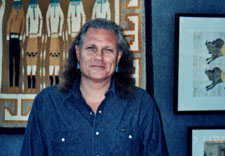
|
PW: Did they talk with you about a longterm plan to finally give Michelle something good in her life, especially after the tragedy with Hannah? To give her a genuinely decent, stable man for a change?
MH: Well, we didn't know where that was going. We didn't know about the stability of the relationship.
PW: Really? So you knew you were going to be a love interest for her, but you didn't know how long it was going to last?
MH: I had no idea how far that was going to go, and how solid it was going to be.
PW: That was season four, I believe, so you were in about the last two and a half seasons of the show?
MH: Yeah.
PW: So you must have spent quite a bit of time in Alberta.
MH: I actually spent about two and a half years, off and on, up there.
PW: But you came home between seasons?
MH: Yeah.
PW: When they were filming, how long did you have to stay up there?
MH: Sometimes I would be up for three or four days, sometimes I would be up for three weeks, depending on if I was doing two or three episodes back to back.
PW: How were the people up there to work with?
MH: Absolutely wonderful, from the crew on up to everybody that stars in it. I have become the biggest Tom Jackson fan. Gordon Tootoosis I want to be when I grow up. A couple of these guys, like Jimmy Herman, I'd known from working down in the States. Tina is just a fantastic human being. Everybody was.
PW: "North of 60" is considered in Canada to be a breakthrough program because the cast was almost entirely native. We don't have any shows like that down here. What differences did you find in the Canadian acting scene for aboriginal actors?
MH: Well, number one, I think that the Canadian actors, the indigenous actors, are a little bit better because most of them come out of theater.
PW: I think that's true of the Anglo actors up there, too.
MH: Yeah, yeah. Everybody on there was a real professional. And there were a couple of naturals that just came off the reserve up there. But basically, I think that's why most of the Canadian Indian actors are a little better. They don't have a big star system up there, so they all come out of community theater, college theater.
And Indian directors. The first time I'd ever worked with an Indian director, working with Gil Cardinal. And that was an experience I really, really enjoyed. It's not that a non-native person won't be sensitive to my culture, or that they aren't brilliant. But they're not going to see the same things. I mean, if we go to this powwow here and you bring a brilliant director, he may see wonderful artistic things to film and capture, but he won't be looking for the same things as somebody that is used to this situation.
PW: What about the opportunities in Canada for native actors versus the U.S.?
MH: Well, it's just better products. They still don't get it down here. Everybody goes, "Oh, but they did 'Dances with Wolves.'" Again, wonderful indigenous theater [in Canada]. The writing again. And women's pieces. Once in a while you'll see something that'll shine through here, but it's never an indigenous woman's piece.
PW: But in Canada it sometimes is. In fact, Tina Keeper is very active in writing and directing theater pieces, right?
MH: Yeah.
PW: Native actors do seem to be more visible in Canada.
MH: And [they have] the aboriginal network now, which is pretty fascinating. They just seem to get it a little more. Down here it's Geronimo, the dysfunctional family, and Pocahontas! When they get ahold of a really good native script [in the U.S.], they immediately strip it of any of the content that they think that non-Indian people won't get. I went to see a wonderful film, "Monsoon Wedding." I don't know a lot about East Indian culture, but I loved it, and I don't want all that stuff taken out. Like they did "The Education of Little Tree" here. The grandfather in the book was a native character, and they wrote him out and James Cromwell did it. He's a wonderful actor, but why do you have to do that? In Canada, they wouldn't have done that.
PW: So you're obviously still doing acting, including some of the "North of 60" movies. What percentage of your time these days is spent on art versus acting?
MH: It depends. It goes back and forth. I just did a pilot for a new series I'm pitching for ABC called "With You in Spirit," about a little news station in the mythical town of Spirit, New Mexico, with Peter Graves and Cheri Oteri. I'm pretty excited about that.
PW: A little native community?
MH: No, no. Just a little town.
PW: What role do you play?
MH: I'm Victor Bluehouse. I'm the technician. There is nothing I cannot fix!
PW: Good luck with that! And have you done any movies recently?
MH: I did a wonderful little independent film called "Dirt" with Jennifer Tilly, my wife Sandra, Luke Perry, Patrick Warburton.
PW: Your wife is an actress, too? I knew she was a craftswoman.
MH: Oh, she's a brilliant actress. A really brilliant actress.
PW: Is that scheduled for release soon?
MH: It's gonna come out soon. They're still trying to find a distributor. Wonderful, funny, funny movie.
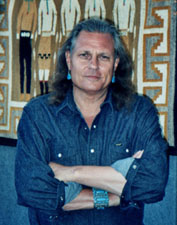
|
PW: What was your character in that?
MH: I'm a convict.
PW: A convict with a heart of gold, or not necessarily? [laughs]
MH: A little bit of both! And [I've been doing] a lot of television: "Malcolm in the Middle," "Walker, Texas Ranger."
PW: And you were in a few episodes of the first season of "Roswell."
MH: Yeah, "Roswell," which I kind of left 'cuz they weren't writing anything for me and it bored me.
PW: I guess you can't really make any other commitments until you see whether "With You in Spirit" is picked up. What about "Dreamkeeper," though? It seems like every native actor in the U.S. and Canada is going to be in that miniseries.
MH: Well, I auditioned for a role in that. I'm waiting to see. I'd play a coyote, and I would really like to do that.
PW: An actual coyote?
MH: Yeah, a virtual coyote. There's wonderful special effects in this.
PW: So they'd create a digital coyote and you'd do the voice?
MH: I would actually be physically me and the coyote. And I'm a lot of voices in the new animated film from Dreamworks, "Spirit," about the horse.
PW: Oh, "Spirit: Stallion of the Cimarron"?
MH: Yeah. I'm pretty much everybody but the lead characters. I'm old women, I'm little kids, dogs, soldiers. I do a lot of that. I do a lot of cartoon things. It's fun.
PW: Going back a ways, how did you like doing "Twin Peaks"?
MH: Another great show. That was probably one of the best native characters ever on American television. He was intelligent, he was intuitive. It also was groundbreaking art. Both as an Indian person and as an artist, I'm very proud of it. If it wasn't for "Twin Peaks," there wouldn't have been "X Files" and "Picket Fences" and "Northern Exposure." It opened all the doors.
PW: For quirky shows? [laughs]
MH: Yes.
PW: You're spending a lot of time these days on your artwork. Please explain a little about the drawings on the walls of the display booth behind us.
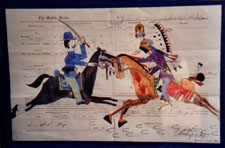
|
MH: I'm a ledger artist, which is a very traditional style of native art. We used to paint our history on buffalo hide, and in the late 1800s, we started using scrap paper that would come around the reservations. Ledger papers and treaties and bibles and love letters and maps and..It's a very traditional folk art, done in crayon, colored pencil, pen and ink, watercolor like I use.
[Note: There's some excellent information about ledger art on the web sites of the University of California, San Diego, and the Massachusetts Historical Society.]
PW: For instance, what's the background paper on this piece here?
MH: This is an actual railroad map from the Ohio and Mississippi Railroad from the late 1800s. I have a Hudson's Bay trading correspondence. Cavalry, military paper. Newspaper items. An actual land treaty from the Indian Territory. Pretty much I use paper from the late 1800s and early 1900s. And I try to use pre-'50s watercolors, because the colors started to change in the '60s. The colors were pretty well standardized in their hues until about the '60s, and then it started to change a little bit. I don't know why, but they did.
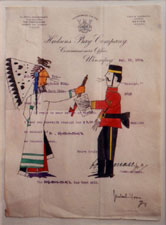
|
PW: So these are really very accurate representations of how ledger art would have looked like around the turn of the century.
MH: Oh yes. That's why I got interested. I work with some of the museums--I work with the Autry, and the Southwest Museum--and I saw a lot of the old original ledger drawings, and I knew this was my history book, coming from my point of view.
PW: Is the style of your drawings--the way you draw people and horses and buffalo--your own style, or did you try to replicate the traditional ledger art style?
MH: A little bit of both.
PW: What you don't have here today, but of course you're well known for, is jewelry.
MH: I didn't do any jewelry this time, but basically I'm a jeweler. I come from a long line, on the Zuni part of my family, of very well known jewelers and potters.
PW: The only piece of your jewelry I've ever actually seen in person was Michelle Kenidi's wedding ring, which Tina Keeper was wearing when I interviewed her. Did you make a wedding ring for Andrew One Sky, too?
MH: Yes.
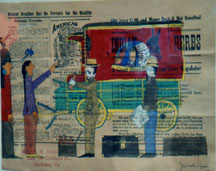
|
PW: The one I saw was silver. I forget whether it had any stones in it. I think it was just silver.
MH: I think it was just silver, yeah.
PW: What materials do you primarily work with?
MH: Silver, turquoise, coral, gold, diamonds.
PW: So you do paintings, you do jewelry. You mentioned that your family has traditionally done pottery, too. Do you do that?
MH: No, I'm the worst potter known to man! [laughs]
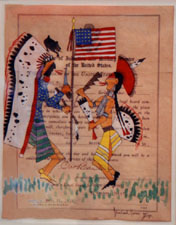
|
PW: Okay, we'll skip pottery! But some of your other work is on exhibit in museums, right?
MH: I have pieces in the Smithsonian through the Heye Foundation, at the Southwest Museum and the Autry [Museum of Western Heritage] in Los Angeles, and the Buffalo Bill Museum in Cody [Wyoming]. There's an exhibit on the katsinas at the Fowler Museum at UCLA.
[Note: The exhibit "Katsina/kachina: Tradition, Appropriation, Innovation" ran from Aug. 20, 2002 to March 23, 2003.]
PW: You make katsina dolls?
MH: Yeah. Not the wooden ones, but they're silver.
PW: Those must be beautiful. I've never seen silver katsinas before.
PW: Before we stop, I wanted to ask about your volunteer work, which I'm sure is very important to you.
MH: I've been working for the American Diabetes Association in a thing called "Awakening the Spirit." Juvenile Type 2 diabetes has gone off the charts on reservations, from bad diets, alcoholism, lack of physical exercise. So my wife and I both travel, we do information programs, fundraisers. And I work with Indian gang kids.
PW: In Los Angeles?
MH: L.A., Arizona, New Mexico.
PW: What do you do with the gang members?
MH: Kind of an Outward Bound program. We take them on long rides, see if we can get them to open up, see what's wrong with them.
PW: I imagine some of them have never been on a horse before?
MH: Some of them have never been out of the city before.
PW: How long have you been doing that?
MH: I've been doing that about two years now. I watched the gang problem spread from my neighborhoods in Los Angeles, four generations, and finally it's on the reservation now, and that's pretty alarming.
PW: How long are the rides?
MH: About 14 days, 10 to 14 days.
PW: That must be quite a shock for city kids.
MH: Well, what we're trying to do is shock them out of their behavior.
PW: Well, I'd better let you get back to the powwow and talking with people who are coming to look at your artwork. Thank you, Michael.
MH: Thank you very much.
[ Click here for a greeting from Michael to Nof60 fans. ]
Text and photos (c) 2002 Patricia F. Winter.
All rights reserved. For personal use only. Do not distribute to other persons by electronic or non-electronic means (including posting on a web site) without prior permission from the copyright owner.
Last updated 6/19/09